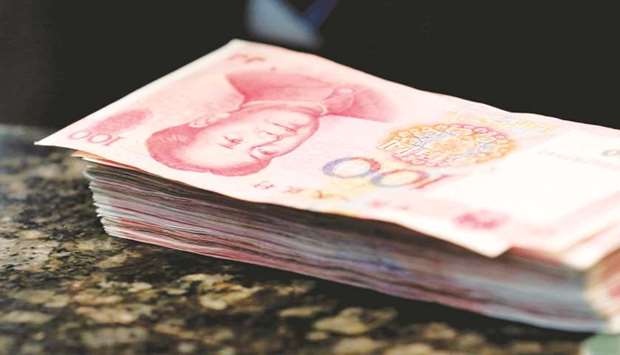Beijing is trying to reduce financial risks by containing rising debt and defusing property bubbles amid fears they could derail the world’s second-largest economy, although policymakers are seen treading warily before a key party meeting next month.
Chinese banks extended 1.09tn yuan ($166.5bn) in net new yuan loans in August, central bank data showed yesterday, well above analysts’ expectations.
Analysts polled by Reuters had predicted new yuan loans of 900bn yuan, up from 825.5bn yuan in July.
“Today’s data are consistent with our view that, having reached a peak during the current business cycle in mid-2016, broad credit growth is now on a downward trajectory,” Julian Evans-Pritchard, Capital Economics’ China economists, said in a report.
Yan Ling, a Shenzhen-based analyst at Merchants Securities, said a gradual slowdown in credit growth, coupled with a steady rise in borrowing costs, could weigh on the economy in the fourth quarter but the expected slowdown may be modest.
Household loans, mostly mortgages, rose to 663.5bn yuan in August from 561.6bn yuan in July, according to Reuters calculations based on the central bank’s data.
Household loans accounted for 61% of total new loans last month, down from 68% in July.
Short-term household loans in August doubled from July to 216.5bn yuan, reflecting a surge in consumer lending as some home buyers may have turned to short-term consumer loans due to curbs on mortgages, analysts said.
Corporate loans climbed to 483bn yuan in August from 353.5bn yuan in July. Broad M2 money supply (M2) in August grew 8.9% from a year earlier, hitting a fresh low since records began in 1996 and missing forecasts for an expansion of 9.1% and compared with July’s 9.2%. China’s central bank has said that the slowing M2 growth could be a “new normal” due to the stepped-up crackdown on risky shadow lending activities.
Total social financing (TSF), a broad measure of credit and liquidity in the economy, rose to 1.48tn yuan in August from 1.22tn yuan in July, the data showed.
Some economists had expected an increase in the TSF to 1.3tn yuan.
Combined trust loans, entrusted loans and undiscounted bankers’ acceptances, which are common forms of shadow banking activity, rose by 130.3bn yuan in August, versus a fall of 64.4bn yuan in July, according to Reuters calculations.
In its second-quarter policy report, the central bank said it would strike a balance between deleveraging and maintaining stable liquidity, suggesting policymakers were keen to keep the economy on an even keel.
Analysts believe the central bank is likely to keep policy steady ahead of the once-in-five-years Communist Party Congress later in October, where President Xi Jinping is expected to consolidate his hold on power.
Regulatory tightening has moderated somewhat amid signs that a surge in money market interest rates earlier this year are trickling down to the real economy, and authorities appear unlikely to tap the brakes any further in the near term.
China posted a flurry of disappointing data on Thursday – including its slowest growth in investment in nearly 18 years – suggesting the economy is finally starting to lose some momentum as borrowing costs rise.
The economy had defied expectations for a slowdown despite the stepped up property curbs and debt crackdown, partly as an infrastructure-led building boom has fed demand and prices for everything from cement to steel to other building products.
Outstanding yuan loans at the end of August grew 13.2% from a year earlier, more than an expected 13% rise but steady with the pace in July.
Analysts say China’s campaign to reduce financial risks this year has had mixed success so far, and opinions differ widely on whether it is moving quickly enough or decisively enough to avert the risk of a debt crisis down the road.
Regulators are making significant inroads in reducing interbank borrowing – perhaps the most pressing risk – and have curbed some riskier types of shadow banking.
However, China’s economy still remains heavily reliant on credit, and analysts agree more comprehensive structural reforms are needed.
Though the pace of credit growth may be easing, new bank lending and total social financing may hit fresh records this year and continue to outpace economic growth. A recent Reuters analysis showed corporate debt is growing faster than last year, with few companies using stronger profits to reduce debt.


